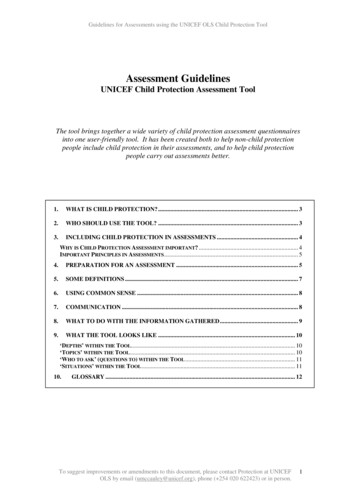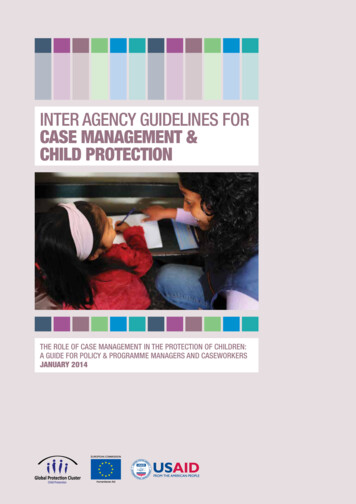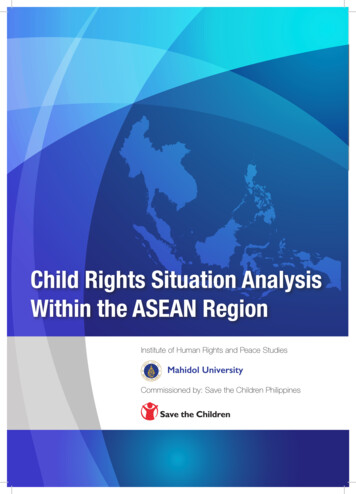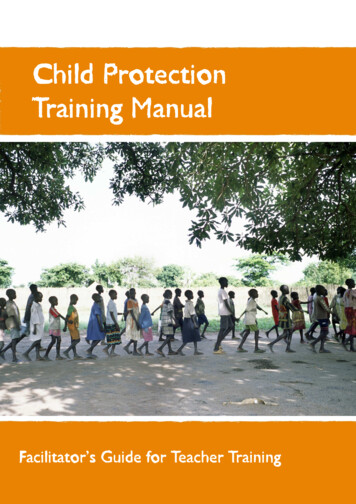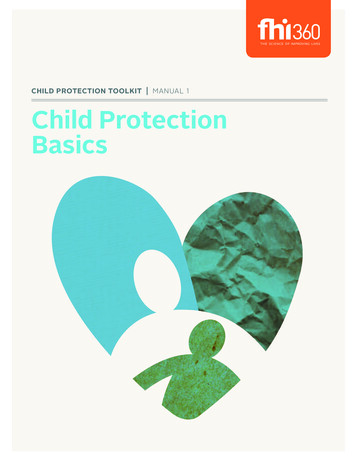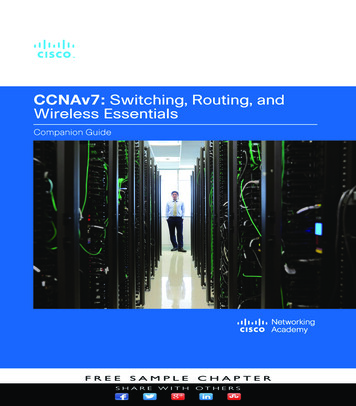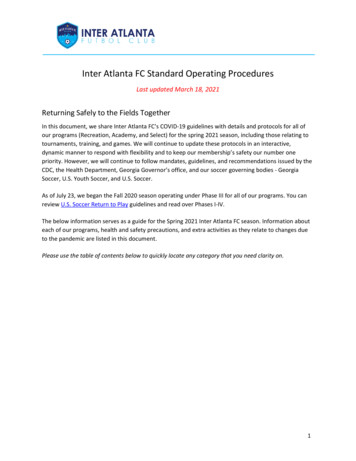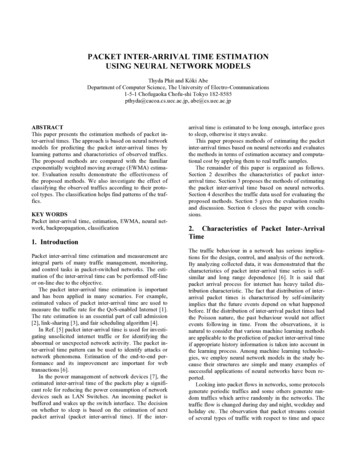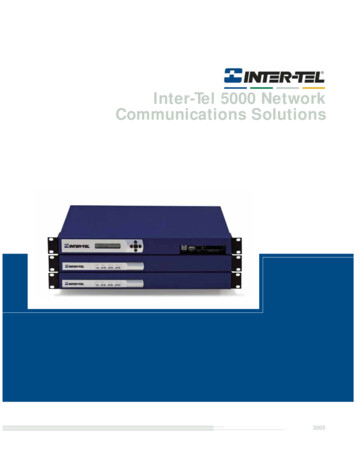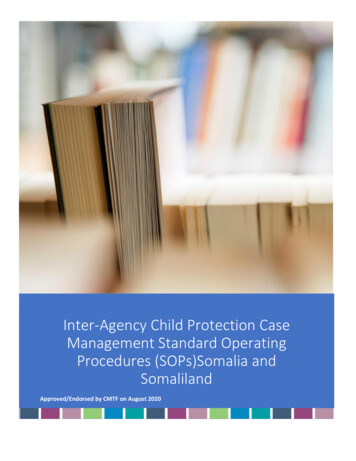
Transcription
Inter-Agency Child Protection CaseManagement Standard OperatingProcedures (SOPs)Somalia andSomalilandApproved/Endorsed by CMTF on August 2020Ranjini Paskarasingam[Date][Course title]
Approved/Endorsed by CMTF on August20201
CountryLocationSomaliaCollaborating agenciesSpecial thanks are extended to all stakeholders who played a leading role in thedevelopment of this SOPs. Particular thanks to the following agencies in Somalia:[Somalia and Somaliland]1. The Ministry of Women andHuman Rights Development(Somalia)2. Ministry of WomenDevelopment and Family Affairs(MoWDAFA- Puntland)3. Ministry of Employment SocialAffairs and Family (MESAF –Somaliland)4. UNICEF5. Save the Children6. INTERSOS7. IOM8. UNHCR9. SWDC10. World Vision11. Relief International12. WAAPO,13. SOS Children's Villages Somalia,14. V AORNew Ways OrganizationOSPADSOYDA,SPLICRCJanuary 2021Revisions2
ContentsINTRODUCTION TO THE CPCM STANDARD OPERATING PROCEDURES . 5DeleSECTION 1: BACKGROUND AND INTRODUCTION . 5Dele1.1Overarching Framework for Child Protection Case Management .5Dele1.2Standards and Best Practices .5Dele1.3Complementary .5Dele1.4Case Management .6Dele1.5Objective and Scope of these SOPs .6Dele1.5.1Objectives of the SOPs:.6Dele1.5.2Scope of the SOPs .7Dele1.6Context Analysis .8Dele1.7National and International Legal framework . 10Dele1.8Dissemination, Review and Revision . 12DeleDeleSECTION 2: DEFINITIONS AND GUIDING PRINCIPLES . 13Definitions of Key Terms . 14Dele2.2. Guiding principles for Case Management: . 20Dele2.1.SECTION 3: ROLES AND RESPONSIBILITIES . 25Dele3.1 Roles and Responsibilities of Key Stakeholders. 25Dele3.1.1.The Role of the Government line Ministries. 25Dele3.1.2.Role of the Child Protection Area of Responsibility (CP AOR) . 26Dele3.1.3.Role of National Child protection Case Management Taskforce (CMTF) . 27Dele3.1.4.Role of field level Child Protection Working Groups . 28Dele3.1.5.Role of Case Management Supervisors . 28Dele3.1.6.Role of Caseworkers . 29Dele3.1.7.The role of Community-Based Child Protection Mechanisms . 30Dele3.1.8.Role of Case Management Agency (International non – Governmental Organizations and National nonGovernmental Organization) . 31Dele3.1.9.Role of UNHCR and case management of refugee cases: . 32Dele3.1.10.The Role of ICRC . 34Dele3
3.2 Caseworkers and Case Management supervisor role and responsibilities, staff ratio, Core Competenciesand Capacity-building . 34Dele3.3 Service Mapping . 36Dele3.4DeleReferral Pathways and Mechanisms . 41SECTION 4: OVERALL RISK ANALYSIS, ELIGIBILITY AND PRIORITISATION OF CASES . 42DeleSECTION 5: CASE MANAGEMENT PROCESS . 45Dele5.1Identify Vulnerable Children and Register . 47Dele5.2Assessment . 47Dele5.3Develop Case Plan . 48Dele5.4Implement the Case Plan. 48Dele5.5Follow up and Review. 49Dele5.6Case Closure . 50DeleDeleSECTION 6: INFORMATION MANAGEMENT . 516.1.Data Protection / Information Sharing . 51Dele6.2.Documentation and Record Keeping . 51Dele6.3.Record Keeping:. 53Dele6.4.Database . 53DeleSECTION 7: SIGNATURES . 54DeleSECTION 8: REFERENCES AND ANNEXES . 55DeleAnnex A: Child Protection Case Management Case Workers ToR . 55DeleAnnex B: Child Protection Case Management Supervisors ToR . 55DeleAnnex C: Term of Reference Child Protection Case Management Taskforce . 55DeleAnnex D: REFERRAL PATHWAYS . 55DeleAnnex E: SAMPLE CASE PRIORITISATION GUIDE FOR CASE MANAGEMENT. 55DeleAnnex G: Data Protection and information sharing protocols . 55DeleAnnex H: CASE MANAGEMENT FORMS. 55DeleAnnex I: GUIDELINES FOR CHILD PROTECTION DESKS . 55DeleAcronym . 56Dele4
INTRODUCTION TO THE CPCM STANDARD OPERATING PROCEDURESThe Somalia inter-agency Standard Operating Procedures (SOPs) for child protection case management describesguiding principles, procedures, roles and responsibilities in the prevention of and response to child rightsviolations, abuse, neglect and exploitation of children in Somalia, including those on the move and childrenassociated with armed forces and armed groups. The SOPs focus on children with protection concerns or those atrisk to ensure their safety and wellbeing.These SOPs were developed through an inter-agency consultative process with government partners, communitybased groups, UN agencies and national and international actors working in child protection under the umbrellaof the Child Protection Area of Responsibility (CP AoR).The SOP will also be reviewed every two years in order to ensure that they are up-to-date and reflect the practicesof the partners. However, child protection actors can request for a review should the SOPs not meet the statedobjectives or if there are has been a significant change to the operational environment.SECTION 1: BACKGROUND AND INTRODUCTION1.1 Overarching Framework for Child Protection Case ManagementThe National CMTF, with participation by, especially the Ministry of Women and Human Rights (Somalia), Ministryof Women Development and Family Affairs (MOWDAFA- Puntland ), Ministry of Employment Social Affairs andFamily (MESAF – Somaliland) produced the following document, titled the Standard Operating Procedures forChild Protection Case Management in Somalia (CM SOP) to outline procedures for Child Protection CaseManagement provided by Government and humanitarian actors. It provides an overarching framework guidingthe work of all child protection partners to address all child protection concerns including violence, abuse, neglectand exploitation in Somalia, regardless of the vulnerability status of individual children.1.2 Standards and Best PracticesThe CM SOP reflects global best practices as outlined in the Minimum Standards for Child Protection inHumanitarian Action-2019 Edition1, and, the Interagency Guidelines on Child Protection Case Management2. Italso builds from and integrates the Standard Operating Procedures for case management CP and GBV in Somaliain 20153 and the emerging national legal framework4. In order to reflect best National practices, the SOPs havebeen developed through an inter-agency and inter-ministerial consultative process with the Government ofSomalia, lead child protection agencies, and the Case Management Taskforce (CMTF)1.3 ComplementaryThe CM SOP, and the accompanying handbook and training package, detail the minimum procedures forprevention and response to Child Protection concerns in Somalia. They are designed to be used together with theexisting resources related to prevention and response to Child Protection including the Interagency SOP on GBV1https://alliancecpha.org/en/CPMS homeProtection Case Management, 20143Case Management and GBV SOP 20154 Somalia has ratified the Convention on the Rights of the Child in 2015. At the time of writing a Child Rights Bill has been drafted by the Ministry of WomenHuman Rights and Development and presented to cabinet for parliamentary processing. Other key legislative amendments are in process includingconfirmation of the provisional constitution, a sexual offences bill, juvenile justice bill and CRVS bill, all of which will be key reference documents for childprotection case workers.2 Child5
for Child Survivors, draft outline of the Strategy and Operational Framework on the Presentation of Recruitment,Release and Reintegration guideline, as well as the draft Child Rights Bill 2019 which will establish an overarchinglegal framework for the protection of children in Somalia5.1.4 Case ManagementCase management is a way of organizing and carrying out work to address an individual child’s (and their family’s)needs in an appropriate, systematic and timely manner, through direct support and/or referrals.Case management is a collective, multidisciplinary process promoting quality and effective outcomes throughcommunication and the provision of appropriate resources to meet an individual’s needs.These processes include assessment, planning, implementation, coordination, monitoring and evaluation ofoptions and services that are available for children. Case management provides a coordinated and holistic systemof identifying, assessing and assisting children at risk of protection violations or those that have already sufferedabuses. Case management aims to ensure vulnerable children and/or survivors receive targeted andcomprehensive services at the earliest possible moment through identification of risk factors or abuse. Casemanagement being a key service as children rarely suffer isolated incidents of abuse but are rather subjected topatterns of abuse due to the diminished power that the child usually has relative to the parent/guardian/adultwho is perpetrating the abuse. The Case worker must therefore negotiate multiple relationships and facilitatemulti-sectoral services to ensure the best interests of the child are served. The case worker also aims to empowerthe survivor or the child (and, where appropriate, their caregiver) by giving her or him increased awareness of thechoices that they have in dealing with the problem (participating) , and assisting her or him to make informeddecisions of what to do about the problem. Case management ensures that the survivor/child is involved in allaspects of the planning and service delivery.A case management approach is, therefore, useful for persons with complex and multiple needs who seek accessto services from a range of service providers, organizations and groups.1.5 Objective and Scope of these SOPs“To provide a common strategy for addressing cases of children who are harmed or at risk of harm and ensuringquality, consistency, coordination in services and adherence to the internationally agreed upon standards on casemanagement.”These SOPs aims to describe guiding principles, procedures, roles and responsibilities in the prevention of andresponse to child protection concerns affecting children and where they are (camp/urban or rural community).The SOPs detail the minimum procedural standards within the case management process, including a commonstrategy for addressing cases of children who are harmed or at risk of harm and ensuring quality, consistency,coordination in services and adherence to internationally agreed upon standards on case management.1.5.1 Objectives of the SOPs: 5To establish a national Standard that ensures Girls and Boys have adequate access to child protection servicesand are protected from violence, abuse, neglect and exploitation at home and in the community, and ensuresthat affected children are receiving appropriate support through the case management process.Expected to be submitted to parliament for review in 2021.6
To create comprehensive and systematic mechanisms that ensure family separation is prevented andresponded to, and that unaccompanied and separated children are cared for and protected in accordancewith their specific needs and in line with the principle of the Best Interests of the Child.To set well-coordinated, predictable and comprehensive standards that guide the support and assistance ofchild protection case workers and other actors involved to run a more efficient and a more effective casemanagement service that captures the diverse needs of the children at the earliest possible time.To structure and strengthen coordination mechanisms at national, regional, district and community levels,and set agreed roles and responsibilities for all organizations and individuals that are involved.To provide a common strategy for addressing cases of children who are harmed or who are at risk of harmand adhering to the guiding principles and protocols in ensuring quality, consistency and coordinated services.To create national mechanisms that enhance child protection data collection, and upgrade its quality andsecurity, to promote the principles of confidentiality, informed consent and best practices by child protectioncase workers.To promote the role of communities in responding to protect children and supporting national structures inidentifying, referring and responding to the needs of the children1.5.2 Scope of the SOPsCase Management is a systematic and individualized process that identifies, prevents and responds to all forms ofviolence, abuse, neglect and exploitation faced by individual children. The subjects of case management thereforeinclude, but are not limited to Internally Displaced Persons (IDP), returnee children, refugees and asylum seekers,host community children, Orphans and Vulnerable Children (OVC), Children Living with Disabilities (PLWD),migrant children ,Unaccompanied and Separated Children (UASC), Children Associated with Armed Forces andGroups (CAAFAG), children in contact with the law, child survivors of GBV; and any other children affected bychild protection concerns as detailed in Annex 1: Vulnerability and Risk Assessment Criteria. It is a primary goalof this SOP to provide positive results for all children in Somalia by harmonizing, consolidating and standardizingexisting services and processes that have developed to address specific issues and concerns.The SOPs place emphasis on child protection best practises to ensure child protection case workers and theirsupervisors manage cases appropriately through the case management system that has been developed andadopted collaboratively by all stakeholders in Somalia. The SOPs are applicable to all the districts in Somalia in allsituations for the provision of quality case management for all children with protection concerns and those at riskof harm.The SOPs detail the minimum procedures for prevention and response to cases of vulnerable children, and theinterventions required to take and manage those cases through the set guidelines and case management stepsfor the organizations managing the cases.These SOPs were developed in collaboration with UNICEF, INTERSOS, Save the Children, government lineministries (Ministry of Women and Human Rights (Somalia), Ministry of Women Development and Family Affairs(MOWDAFA- Puntland), Ministry of Employment Social Affairs and Family (MESAF – Somaliland), SWDC, WVI,INTERSOS, IOM, ICRC, UNHCR, WAAPO, SWDC, SOS Children's Villages Somalia, SOCDA, USWRO, OSPAD, SOYDA,SPL, CEDA, SCWRW, DRC, CISP, SCI, WIWA, KANAWA, SOYVA, SSYO, ARADO,SSYO, YOVENCO, BAAHIKOOB,7
NAGAAD and New Ways Organization. This document is designed to be used in coordination with (national andinternational resources, policies and standards).1.6 Context AnalysisSomalia continues to experience the most complex and longstanding humanitarian crisis in the world and hasbeen named among the world’s ten poorest countries with least protective environments for children. Thepopulation is estimated to have grown to over 15 million in 2019 where 50.14% of the population are women and44% of the population are children below 15 years and 43% of the population live in extreme poverty. Accordingto UNHCR, there are 2.6 million people displaced person in the country while the 2020 Humanitarian ResponsePlan (HRP) estimates that 5.2 million people are in dire need of humanitarian assistance and will require urgentlife-saving support. As of November 2020, Somalia host 24,073 refugees and asylum seekers among which 13,115are children. The majority of refugees and asylum seekers are hosted in Somaliland (55%), followed by Puntland(37%) and South and Central regions (8%). UNHCR projects the total number of refugees and asylum seekers in2021 to stand at 28,002. Further, UNHCR projects the total number of assisted refugee returnees in the countryin 2021 to stand at 109,989 individuals, including 18,050 that are expected to be assisted with return in the courseof 2021. According to UNHCR data, out of the total refugee returnee population, 57% are children (27% are girlsand 30% are boys).The current crisis has serious implications upon the protective environment for children predisposing them toabuse, violence, neglect, and exploitation. Key risks for children include family separation and child recruitment,arbitrary arrest, an elevated exposure to GBV including early marriage, female genital mutilation/cutting,trafficking, psychosocial distress, a lack of access to education and hazardous child labour. Al Shabaab hasengaged in intensified recruitment among Somalia’s many unemployed young men and has increasingly resortedto forcible abductions of children.From 1 August 2016 to 30 September 2019, the country task force verified 14,856 violations against 12,551children (2,103 girls, 10,448 boys). The main perpetrators were Al-Shabaab (10,672), followed by the SomaliNational Army (834), regional forces (707), clan militias (494), the Somali police (248), Ahl al-Sunna wal-Jama‘a(125), the Westland militia (7), National Intelligence and Security Agency (1), and pro-ISIL elements in Somalia (1).AMISOM (64), the Ethiopian Liyu Police (18), the Kenya Defense Forces (8) and the Ethiopian National DefenseForces (5) were also responsible for grave violations against children. Responsibility for the remaining 1,672violations could not be attributed.The children were victims of recruitment (6,143 children), killing and maiming (2,916), Rape and other forms ofsexual violence (958) abduction (4,462). In addition, there were 203 attacks on schools, 39 attacks on hospitals,and 148 incidents of denial of humanitarian access.Of grave concern is the arbitrary arrest of children and young people by Government Security forces, where a totalof 910 children (17 girls, 893 boys) were verified as having been detained for alleged association with Al-Shabaabor pro-ISIL elements in Somalia.Migrant children, in displacement, and affected by conflict and food insecurity face aggravated protection risks.While societal customs are an enabling factor for child marriages, 59 per cent of respondents to a recentassessment indicated early marriage is more likely in the context of drought due to monetary incentives and theassumption that the husband will care for the child bride. Access to education is compromised due to the closure8
of schools in affected areas and a lack of capacity in areas where the displaced settle. Coping strategies indisplacement exacerbate the situation by forcing families to resort to (hazardous) child labour and early forcedmarriage.Forcible recruitment and clan-negotiated recruitment of children play an important role in some communities. AlShabaab is brutal and imposes tight control of children as well as adults. Beyond brutal sharia punishment, suchas stoning or cutting of limbs, which are not readily acceptable to most Somalis, the group also overreaches inother exercises of its power.Forced displacement continues to induce family separation, particularly separation of children from their families.9,513 separated and unaccompanied children were identified, registered and provided with services from Januaryto June 2020 by the CP sub-cluster, this was more than Jan -Dec 2019 which was at 7,519 and with this trend weexpect to double last year figure by end of this year, mainly in Southern areas of Somalia. Fear of recruitment byal-Shabaab has also encouraged the voluntary separation and displacement of children as they are being sent byparents into areas of safety. In addition to family separation due to children being transferred to anothercaregiver, the death of parents and engagement in child labour were recorded as the main reasons for familyseparation in the context of the drought and conflict. Further, field reports indicate fears amongst youth and menof moving towards towns where humanitarian assistance is provided arise because of the frequent arrests ofyouth by security forces leading to family separation. This dynamic – on occasion – is reported to impact onaccessibility of IDP sites for young (unaccompanied) men due to obstruction by gatekeepers who fear disturbancesor complications due to the presence of youths.Somalia represents a key country of origin, transit and return for migrants in the Horn of Africa, with a multifacedand complex mobility and migration environment characterized by conflicts, natural hazards and irregularmigration and movements along the Eastern Route - from the East and Horn of Africa via Yemen into GulfCountries- remained on an upward trend, with a total of 468,234 movements tracked along the Eastern Route in2019. On the other hand, data on the number of Somalis returning from the Kingdom of Saudi Arabia (KSA) islimited, with an overall 4,000 reported to be returned to Somalia during 2019.In the past year, an upward trend over the % migrant children travelling alone has been highlighted along theEastern Route. Migrant children may travel completely alone, with adults unrelated to them or with familymembers. Some embark on their migratory journey accompanied, although they might become unaccompaniedor separated during the journey and/or after arrival in the host country. During the migration journey, risk factorsincrease due to exposure to violence, abuse and exploitation, lack of access to basic services such as adequateaccommodation, sanitation facilities, education, dangerous living conditions, gaps in child protection systems andgovernmental response, as well as access to legal assistance and international protection. In this transition phase,vulnerabilities are the most heightened for children; Smuggling routes are usually through isolated, precariousand remote areas; as such, protection-oriented services are very limited and access to justice almost nonexistent.Service provision targeting children continues to be challenged due to security constraints and lack of capacity ofservice providers, especially in remote and/or conflict affected areas: 12 per cent (104 girls, 106 boys) of childrenaffected by grave violations were reached with support services (community engagement, medical and9
psychosocial), while capacity to address child protection needs in IDP sites remains low. Children make up 63% ofthe displaced and their rights as well as rights of other children across Somalia, remain severely compromised.The above noted challenges hamper the delivery of protection to the most affected areas of the country andconstrain the ability of humanitarian actors to identify and respond to the needs of the most vulnerable children.Despite significant efforts by all actors, these challenges, coupled with lack of services and systems in place, havelimited the ability of child protection partners to provide systematic child protection interventions, including casemanagement for vulnerable children, unaccompanied and separated children (UASC) and other children at risk. Itis in this context that child protection partners have come together as the case management task force (CMTF).Current responses tailor case management system on the specific issues concerning children. The SOP is to defineclear roles and responsibilities for different child protection actors are required to address the various critical childprotection issues.The digital child protection information management system (Primero CPIMS ) has been launched in Somalilandand Puntland, and soon to be launched in Benadir and all Federal Member States to standardize informationmanagement process as primary tool for storing data, processing and sharing per the ISP.1.7National and International Legal frameworkSomalia ratified of the Convention on the Rights of the Child (CRC)6 – on 20th January 2015 paving way towardsprotecting and promoting the rights of all children. The right to be free from physical, sexual, and emotional abusein the family or in any other societal setting is spelled out in articles 16, 19 and 39 of the Convention of the Rightsof the Child (CRC). The formal legal system provides critical protections to children but also contains several gapsthat need to be addressed. The government’s recognition of international standards with regard to the rights ofchildren is laudable. The National Child Protection Policy 2016 recognizes the authority of the UN Convention onthe Rights of the Child and the African Charter on the Rights and Welfare of the Child, both of which stipulate thatthe best interests of the child should guide all decision-making about the child and that all children should enjoythe rights outlined in the Conventions without discrimination. The policy explicitly commits the government torespect the rights of the children in difficult circumstances, including children with protection con
Inter-Agency Child Protection Case Management Standard Operating Procedures (SOPs)Somalia and Somaliland Approved/Endorsed by CMTF on August 2020

